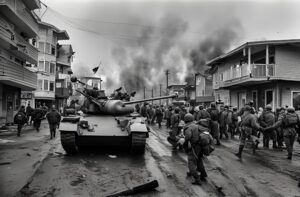
In the early hours of a frigid January morning, the residents of Anchorage were jolted awake by the ominous rumble of heavy machinery and the distant, rhythmic thumping of helicopters. It was neither an earthquake nor a storm but something far more sinister: Russia had invaded Alaska.
The invasion was swift and meticulously planned. Under the cover of darkness, Russian forces crossed the Bering Strait, exploiting the narrowest point between the two continents. They moved with military precision, securing key locations along Alaska’s western coast before the United States could react. By dawn, Russian flags were flying over several Alaskan towns, thrusting the world into a new era of geopolitical tension.

The initial shock of the invasion sent ripples through the global community. The United Nations convened an emergency session, and NATO countries scrambled to assess the situation. The United States caught off guard, declared a state of emergency and began mobilizing its military forces. President Emily Carter addressed the nation with a voice resolute yet tinged with urgency. “We will not stand idly by while our sovereign territory is taken by force. We will defend our land, our people, and our way of life.”
As days turned into weeks, the conflict escalated. The Alaskan wilderness, with its harsh climate and rugged terrain, became a battleground. Russian and American forces clashed in a series of intense skirmishes, each side vying for control of key strategic points. The once peaceful towns of Nome, Bethel, and Kotzebue were transformed into war zones, their residents caught in the crossfire.
The human cost of the conflict was staggering. Families were torn apart, homes destroyed, and lives lost. Alaskan Native communities, who had lived in harmony with the land for generations, found themselves displaced and struggling to survive. The world watched in horror as the conflict unfolded, images of destruction and suffering broadcasted across every screen.

Amidst the chaos, a glimmer of hope emerged. A group of Alaskan resistance fighters, comprised of both Native Alaskans and settlers, banded together to defend their homeland. They were led by a charismatic and resourceful former park ranger named Jack Thompson. With his intimate knowledge of the Alaskan wilderness, Jack orchestrated guerrilla tactics that kept the Russian forces on edge.
The resistance fighters became a symbol of hope and resilience, their exploits inspiring people around the world. They sabotaged supply lines, conducted daring raids, and provided crucial intelligence to the American military. Their efforts did not go unnoticed, and soon, they were receiving support from other nations. Canada, Japan, and several European countries sent aid and supplies, bolstering the resistance’s efforts.
As the conflict dragged on, the toll on both sides became increasingly apparent. The harsh Alaskan winter took its toll on the Russian forces, who were unprepared for the extreme conditions. Morale began to wane, and dissent grew within the ranks. The American military, now fully mobilized, launched a series of counteroffensives, gradually reclaiming lost territory.
The turning point came in the spring when a decisive battle was fought in the shadow of Denali, North America’s highest peak. The American forces, bolstered by the resistance fighters, launched a coordinated assault on the Russian stronghold. The battle was fierce and brutal, but in the end, the American flag was raised once again over the Alaskan wilderness.
The aftermath of the conflict left Alaska scarred but unbroken. The rebuilding process was long and arduous, but the resilience of the Alaskan people shone through. Communities came together to rebuild their homes, and the bonds forged in the crucible of war endured. The conflict had a profound impact on the global stage, reshaping alliances and altering the balance of power.
In the years that followed, Alaska became a symbol of resilience and unity. The story of the resistance fighters, led by Jack Thompson, was immortalized in books, films, and songs. The lessons learned from the conflict prompted a renewed focus on diplomacy and cooperation, as the world sought to prevent such a tragedy from ever occurring again.




